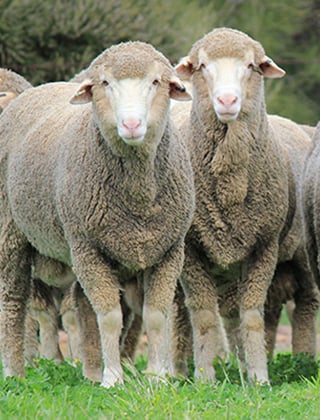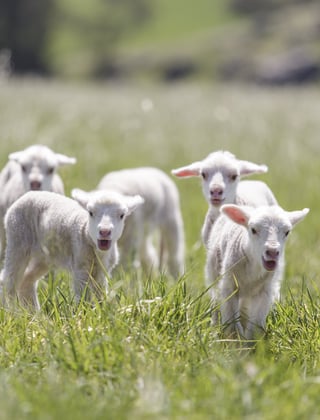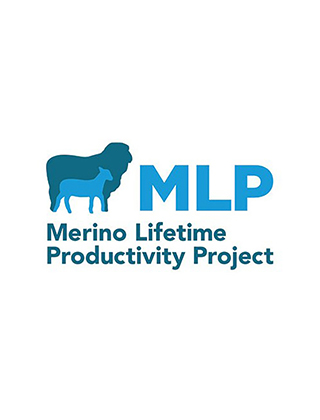Wrinkle expression in the MLP project

As the Merino Lifetime Productivity (MLP) project approaches completion, we can increasingly use this valuable industry resource to answer a range of questions relevant to Merino sheep producers. In this article we use the MLP project data to explore how Australian Sheep Breeding Values for breech wrinkle relate to actual raw measurements or scores on farm.
Australian Sheep Breeding Values (ASBVs) are one of many tools available to support breeding decisions. They allow the comparison of genetics between animals across flocks, environments, and time. A common question asked when using ASBVs is, “How do breeding values relate to actual raw measurements or scores on farm?” This has been particularly the case for fibre diameter, although in recent times, questions about breech wrinkle have also emerged. In this article, we use the MLP project data to help answer this question.
Breech wrinkle is the leading cause of breech strike in Merinos and over the past 10 years we have seen breeders making efforts to reduce breech wrinkle with the aim of breeding more naturally flystrike resistant Merinos. Research has shown that a breech wrinkle of score 2.0 or less (based on the Visual Sheep Scores guide) will significantly reduce the incidence of breech strike in a flock.
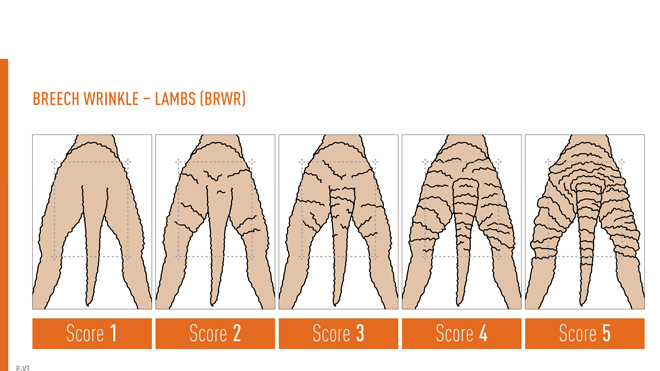
The Visual Sheep Scores guide provides a standardised framework for scoring and assessing visual sheep traits, such as breech wrinkle (above). The 76-page guide is available at www.wool.com/flystrikelatest/#breeding
For users of ASBVs, they often ask, “What breech wrinkle breeding value (EBWR) is needed to achieve score 2.0 on my farm?”
What we can see, measure, or score directly from a sheep is described as the animal’s phenotype. Phenotype is influenced by both a sheep’s genes and the environment in which it has been raised (both before and after birth). The heritability of a trait indicates how much of the variation in a trait is a result of genetics, and ranges from 0 to 1. Breech wrinkle has a heritability of 0.3 (or 30%) meaning that 0.7 (or 70%) of the difference in performance between animals is owing to non-genetic influences that we describe as environmental factors.
EBWR ASBVs are a prediction of the genetic difference in breech wrinkle between animals. The value can be positive reflecting higher breech wrinkle, or negative reflecting a lower breech wrinkle. If two sires have a one-score difference in EBWR ASBV, it is anticipated that their progeny will exhibit a half-score difference in wrinkle score, given that their offspring inherit half of their genes from their sire and half from their dam.
The difference in actual wrinkle raw score of progeny may differ from what is predicted from their parents ASBVs. The MLP project has shown that wrinkle-based sire performance rankings remain very consistent across environments and flocks (ie sires rank similarly across environments), yet the extent of difference in performance is associated with the degree of wrinkle expression within a specific flock or environment. Environments and flocks with low wrinkle expression may experience lower variation in wrinkle scores among sires, whereas those with high wrinkle expression might see a broader range of wrinkle scores.
Within a flock, if progeny have undergone similar conditions post-birth, factors preceding their birth also play a role in wrinkle expression. For instance, lambs born as twins exhibit a lower wrinkle score compared to single-born lambs by between 0.3 to 0.5 scores, and offspring from maiden ewes tend to have wrinkle scores 0.1 to 0.2 lower than those born from adults.
Using the five MLP project sites as an example, we can explore how different EBWR ASBVs are expressed at each site. The sites were spread across a range of geographical locations with differing average temperature, rainfall patterns and disease pressures, and were also founded on differing Merino ewe types. Common sires (link sires) were used to create genetic linkage or a genetic reference between the sites, and we can use these sires to look at the impact of each site’s environment on performance.
Two link sires were used across three sites in the MLP project 2016 joining, and a further two link sires were used across four sites in the 2017 joining.
Looking at the 2017 joining, Sire A has an EBWR ASBV of -1.4 and Sire B has an ASBV of 0.2. We expect that the progeny of Sire B will have a higher wrinkle score than Sire A by about 0.8 score at the sites (we need to halve difference in their breeding values). Figure 1 shows that the average marking breech wrinkle is similar between the MerinoLink, Macquarie and New England sites, while the Pingelly site is considerably lower. As predicted by the ASBVs, we see that Sire B’s progeny are wrinklier than Sire A’s progeny across all the sites with some variation associated with the different levels of wrinkle expression at each site. Sire B’s wrinkle is higher than Sire A’s by 0.7 at Pingelly, 0.7 at MerinoLink, 1.0 at Macquarie and 1.4 at the New England site. We also see that the sire’s progeny has different breech wrinkle at each site, with Sire A’s progeny ranging from score 1.3 to 1.8 and Sire B from 2.2 to 2.8.
Figure 1: Average marking breech wrinkle for progeny of link sires in 2017
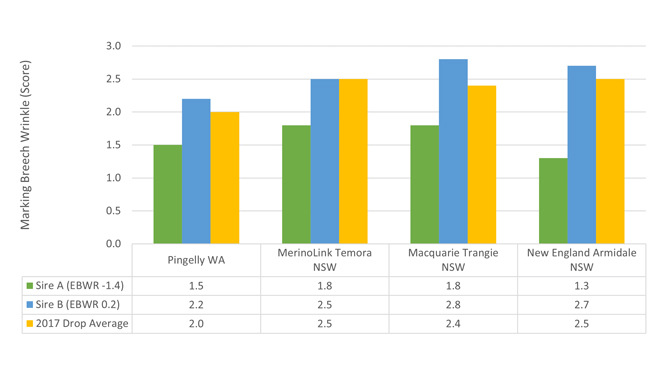
The link sires used in the 2016 drop differed in EBWR ASBVs by 2.6 with an expected progeny difference of 1.3 in wrinkle score. Figure 2 shows the sire’s EBWR ASBV along with the progeny score from three sites. As predicted, Sire D is wrinklier than Sire C across all sites with a difference of 2.1 at Balmoral, 0.9 at Pingelly and 2.5 at the MerinoLink site.
It’s good to note the difference in the average wrinkle scores at the same site but between the drops, eg the Pingelly 2017 drop averaged 2.0 while Pingelly 2016 drop averaged 2.3. The average in each drop is influenced by environmental factors, any changes in the ewe base between joinings, and the different mix of sires used in the two joinings. This highlights the importance of comparing raw scores within the same management group and drop because the scores are more likely to have been influenced by the same factors.
Figure 2: Average marking breech wrinkle for progeny of link sires in 2016
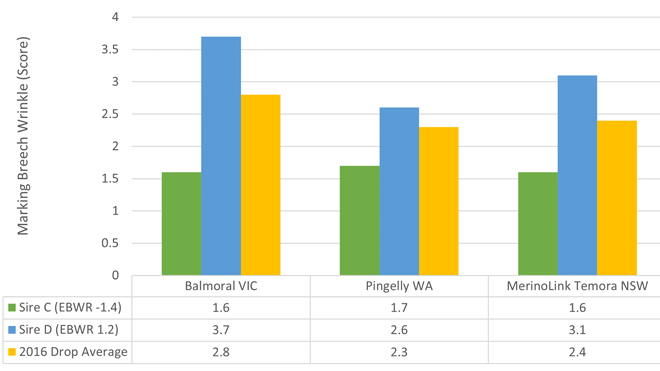
Wrap up
The work here shows that the raw measurement and scores achieved on farm using ASBVs will depend on your environment and current genetics. For woolgrowers aiming to achieve a breech wrinkle score of 2.0 on farm they will need to do some homework to determine what EBWR ASBV to target. The AWI-developed ClassiFlyTM workshop aims to support woolgrowers breeding for more flystrike resistance and can help them to work through this process. See the article in this edition of Beyond the Bale for more details about the ClassiFlyTM workshops and how to attend.
Future articles will delve further into the likely EBWR ASBV needed for all progeny to hit the target 2.0 raw score at each MLP Site, although this early investigation suggests that based on the genetics and the environment at each site, the values would need to be less than –0.3 and possibly closer to -1.0 for some sites.
On the topic of flystrike, in a project first the New England MLP sires will have research flystrike breeding values available at the final field day on 29 May. We invite industry to join us on the day as we delve into the genetics of natural flystrike resistance and celebrate the end of data collection in the MLP Project.
Notes
In presenting these EBWR ASBVs, the MLP project recognises that the visual scores reported here were used in the generation of the sire ASBVs and are not independent of each other. The link sires have 3818 progeny assessed in MERINOSELECT although just 30% of those records are from the MLP project.
We also emphasise that ASBVs are just one tool in the breeding selection tool kit, and breech wrinkle is just one trait of several traits that may or may not be considered in a breeding program.
FINAL New England MLP Field Day
Wednesday 29 May, 2024
'Chiswick' CSIRO,
New England Highway, Uralla, NSW
MLP project sheep, results, research flystrike
breeding values, presentations and more
For more info: Todd Whilock 0427 740 283
MLP quick facts
The AWI-funded MLP project is a $13 million ($8million from AWI plus $5 million from project partners), 10-year venture between AWI, the Australian Merino Sire Evaluation Association (AMSEA), nominating stud Merino breeders and site partners.
- Balmoral, Vic
Partner: Tuloona Pastoral
Committee: Balmoral Breeders Association
- Pingelly, WA
Partner: Murdoch University / UWA
Committee: Federation of Performance Sheep Breeders (WA Branch)
- MerinoLink, Temora NSW
Partner: Moses & Son
Committee: MerinoLink Limited
- Macquarie, Trangie NSW
Partner: NSW DPI
Committee: Macquarie Sire Evaluation Association
- New England, NSW
Partner: CSIRO
Committee: New England Merino Sire Evaluation Association
The MLP project is tracking the lifetime performance of 5,700 ewes as they proceed through four to five joinings and annual shearings.
A full suite of assessments is being undertaken including visual trait scoring, classer gradings, objective assessments of a range of key traits and index evaluations.
A unique and extensive dataset will result and be used to enhance existing Merino breeding and selection strategies, for both ram sellers and buyers, to deliver greater lifetime productivity and woolgrower returns.
To stay up to date with the latest MLP findings, visit www.wool.com/MLP. Subscribe to MLP updates via www.merinosuperiorsires.com.au/contact-us
This article appeared in the March 2024 edition of AWI’s Beyond the Bale magazine. Reproduction of the article is encouraged.






